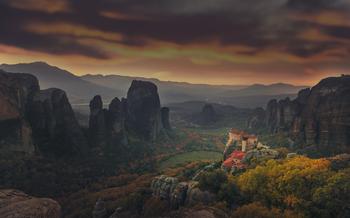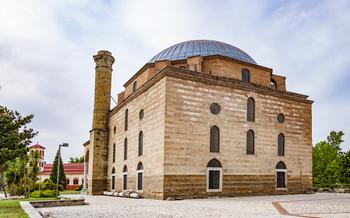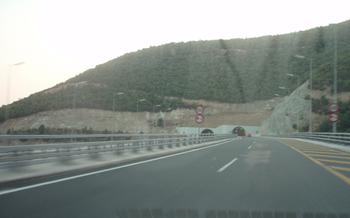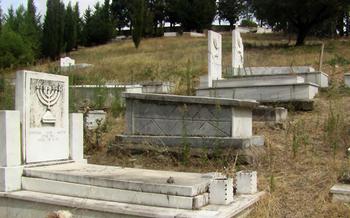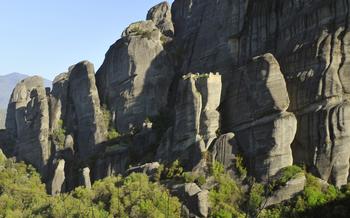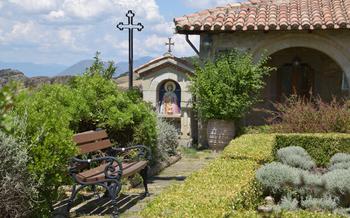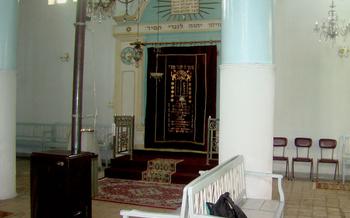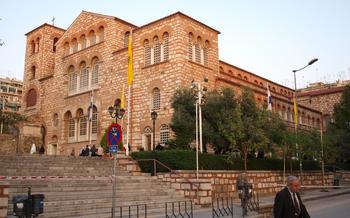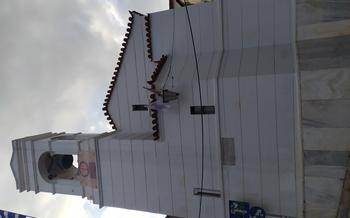
The Stone Forest of Meteora (further away but a notable attraction)
- Breathtaking Landscapes
- Monasteries of Meteora
- Hiking and Outdoor Activities
- Rock Climbing Paradise
- Meteora Villages
- History and Culture
- Photography Opportunities
- Pilgrimage and Spiritual Center
- Wildlife and Nature
- Festivals and Events
- Accommodation Options
- Getting There and Around
- Planning Your Visit
- Local Customs and Etiquette
- Insider Tip: Unveiling the Hidden Treasures of Meteora
Breathtaking Landscapes
Meteora, a UNESCO World Heritage Site, is renowned for its stunning natural beauty and unique geological formations. The towering rock pillars, shaped by millions of years of erosion, create a dramatic backdrop for the monasteries perched atop them.
Monasteries and Panoramic Views: The monasteries, built between the 14th and 16th centuries, offer breathtaking panoramic views of the surrounding landscape. Visitors can marvel at the architectural feats of these structures, seemingly defying gravity as they cling to the sheer cliffs.
Geological Wonder: Meteora's unique geology is a result of a combination of tectonic shifts, weathering, and erosion. The sandstone formations, known as "meteora" in Greek, have been shaped over time by wind, rain, and earthquakes, creating the distinct pillars and outcrops that define the region.
UNESCO Recognition: In 1988, Meteora was inscribed as a UNESCO World Heritage Site, recognizing its outstanding universal value. The site is a testament to the harmonious coexistence of nature and cultural heritage, attracting visitors from around the world who come to witness its awe-inspiring beauty.
Monasteries of Meteora
The monasteries of Meteora stand as testaments to the ingenuity and determination of the early Christian monks who sought refuge and solitude in these towering rock formations. Built between the 14th and 16th centuries, these monasteries offer a glimpse into the rich history and spiritual traditions of Greek Orthodox Christianity.
Each monastery is unique in its architectural style and design, reflecting the different periods in which they were constructed. The interiors are adorned with intricate frescoes depicting biblical scenes and the lives of saints, showcasing the artistic talents of the monks who resided here.
Today, only a handful of the original 24 monasteries remain inhabited, housing a small community of monks and nuns who continue to uphold the centuries-old monastic traditions. Visitors are welcome to explore these sacred spaces, marvel at the stunning frescoes, and learn about the daily life of the monastic community.
The monasteries of Meteora serve as a reminder of the enduring power of faith and the quest for spiritual enlightenment. They stand as symbols of resilience, offering a glimpse into a world where the pursuit of divine connection transcends the limitations of the physical realm.
Hiking and Outdoor Activities
Meteora offers a paradise for hiking enthusiasts, with an extensive network of well-marked trails that cater to all levels of hikers. These trails wind through the breathtaking landscape, providing panoramic views of the monasteries and the surrounding countryside. Along the way, hikers can explore hidden caves, discover unique rock formations, and immerse themselves in the tranquility of nature.
For those seeking an adrenaline rush, Meteora's unique geography presents a thrilling opportunity for rock climbing. With a variety of routes ranging from beginner to expert levels, climbers can experience the challenge of scaling these towering rock pillars. The stunning views from the top of the cliffs make the effort all the more rewarding.
Whether you're an experienced hiker or a casual nature lover, Meteora offers an unforgettable outdoor experience. When embarking on your hiking or climbing adventure, remember to wear comfortable shoes, bring plenty of water, and be prepared for the weather conditions. It's also advisable to inform someone about your planned route and expected return time for safety reasons.
Rock Climbing Paradise
Meteora's towering rock formations and unique geological features have made it a world-renowned rock climbing destination. With over 600 established climbing routes, Meteora offers a diverse range of challenges and rewards for climbers of all skill levels. The rock formations, composed of sandstone and conglomerate, provide a variety of surfaces and textures, making each climb unique and exciting.
One of the main attractions for climbers is the opportunity to scale the sheer cliffs and ascend to the monasteries perched atop the rock pillars. These climbs offer breathtaking views of the surrounding landscape and a sense of accomplishment that is unmatched. For experienced climbers, there are challenging routes that require technical skill and endurance, while beginners can find easier climbs that are still thrilling and rewarding.
Rock climbing in Meteora is not without its challenges. The steep cliffs and exposed rock faces require proper safety precautions and equipment. Climbers should be experienced and well-prepared, using ropes, harnesses, and other safety gear. The weather can also be a factor, as strong winds and rain can make climbing dangerous.
For those who are new to rock climbing, there are several guiding companies that offer guided climbs and instruction. These companies provide all the necessary equipment and guidance to ensure a safe and enjoyable experience. Whether you are a seasoned climber or just starting out, Meteora offers an unforgettable rock climbing experience amidst stunning natural beauty.
Meteora Villages
In the shadow of the celestial pinnacles, where the towering rocks meet the fertile land, lie the charming villages of Kastraki and Kalabaka, the gateways to Meteora's wonders. These villages, steeped in tradition and surrounded by breathtaking scenery, offer a welcoming embrace to weary travelers and adventure seekers alike.
Kastraki, nestled amidst olive groves and towering cliffs, enchants visitors with its picturesque cobblestone streets and traditional stone houses. The village exudes an air of serenity, inviting you to lose yourself in its tranquil ambiance. As you wander through its narrow alleys, discover charming cafes, inviting tavernas, and unique shops showcasing local crafts.
Neighboring Kalabaka, just a stone's throw away, pulsates with a vibrant energy. This bustling town serves as the central hub for exploring Meteora, offering a wide range of amenities and services. Immerse yourself in the lively atmosphere as you stroll along the main square, lined with shops, restaurants, and cafes. Savor the delectable flavors of traditional Greek cuisine, indulge in local delicacies, and find unique souvenirs to cherish your Meteora experience.
Both Kastraki and Kalabaka offer a diverse range of accommodation options, from cozy guesthouses and family-run hotels to luxurious resorts with stunning views. Whether you seek rustic charm or modern comforts, you'll find the perfect place to rest and rejuvenate after a day of exploring Meteora's wonders.
As you venture through these villages, be sure to engage with the warm and hospitable locals, eager to share stories, traditions, and recommendations. Embrace the opportunity to learn about their way of life, rooted in the deep connection to Meteora's sacred landscape.
Use Kastraki and Kalabaka as your base to delve into the heart of Meteora. Let these villages be your starting point for unforgettable adventures, where history, nature, and spirituality intertwine to create an extraordinary tapestry of experiences.
History and Culture
Meteora's rich history is intertwined with its stunning natural beauty. Early Christian hermits sought refuge in these rock formations, establishing monasteries from the 11th century onwards. These monasteries played a crucial role in preserving Greek Orthodox Christianity during times of turmoil, becoming symbols of faith and resilience. Meteora's monasteries served as hideouts for Greek rebels during the Ottoman occupation and were instrumental in the Greek War of Independence.
The cultural heritage of Meteora extends beyond its monasteries. The region boasts unique traditions and customs, reflecting its diverse history. Visitors can immerse themselves in the local culture by attending traditional festivals, sampling the delectable Meteora cuisine, and engaging with the friendly locals. Meteora cheese, a local specialty, is a must-try for cheese enthusiasts.
History buffs will find plenty to explore in Meteora. The monasteries house a treasure trove of Byzantine art, including stunning frescoes and intricate mosaics. Visitors can also delve into the history of Meteora at the Meteora Museum of Natural History and the Meteora Museum of Geology. These museums provide insights into the region's geological formations and the evolution of its unique ecosystem.
Photography Opportunities
Meteora is a photographer's paradise, with endless opportunities to capture stunning images of the monasteries, landscapes, and rock formations. The unique geological features, the interplay of light and shadow, and the vibrant colors at sunrise and sunset create a visual feast for photographers of all skill levels.
To capture the best photos of Meteora, consider using a wide-angle lens to capture the grandeur of the monasteries and the vastness of the landscape. A telephoto lens can be useful for zooming in on the intricate details of the frescoes and rock formations. Experiment with different shutter speeds to capture the movement of clouds or the blur of a waterfall.
The best time of day for photography in Meteora is during the golden hours of sunrise and sunset, when the warm light casts a magical glow on the landscape. However, the midday sun can also create dramatic shadows and highlights, allowing you to capture the textures and depth of the rock formations.
To enhance your photography, consider using filters to adjust the colors and contrast of your images. A polarizing filter can help to reduce glare and reflections, while a neutral density filter can help to balance the exposure between the bright sky and the darker foreground.
Whether you are an amateur photographer or a seasoned professional, Meteora offers endless possibilities for capturing stunning images that will leave you with lasting memories of this awe-inspiring destination.
Pilgrimage and Spiritual Center
Meteora holds deep spiritual significance as a pilgrimage site for Orthodox Christians. The monasteries perched atop the towering rock formations have been a place of worship and contemplation for centuries. Pilgrims from around the world come to Meteora to experience the tranquility and spirituality of these sacred sites.
The monasteries offer a glimpse into the monastic life, where monks and nuns devote their lives to prayer, meditation, and service. Visitors can attend religious services, witness the daily rituals of the monastic community, and learn about the history and traditions of Orthodox Christianity.
The spiritual atmosphere of Meteora is palpable, and visitors often leave feeling a sense of peace, renewal, and inspiration. For those seeking a deeper connection with their faith, a pilgrimage to Meteora is a truly transformative experience.
Tips for planning a pilgrimage to Meteora:
-
Plan your visit during the off-season (October to April) to avoid the crowds and experience a more intimate atmosphere.
-
Attend a religious service at one of the monasteries to immerse yourself in the spiritual traditions of Meteora.
-
Respect the customs and traditions of the monasteries, such as dressing modestly and maintaining silence in certain areas.
-
Take advantage of the opportunity to speak with the monks and nuns about their experiences and insights.
-
Visit the nearby town of Kalabaka to learn more about the history and culture of Meteora.
Wildlife and Nature
Meteora's unique ecosystem is home to a diverse array of flora and fauna. The towering cliffs provide a habitat for a variety of birds, including eagles, hawks, and falcons. The surrounding forests are home to mammals such as deer, foxes, and rabbits. Wildflowers and other plants thrive in the region's unique microclimate.
One of the highlights for nature enthusiasts is the opportunity to spot rare and endangered species. The Eurasian eagle-owl, one of the largest owls in the world, can be seen soaring over the cliffs. The Greek tortoise, a threatened species, can be found in the forests and grasslands.
Meteora's natural environment is fragile and in need of protection. Visitors are encouraged to respect the wildlife and their habitat. Avoid littering, disturbing animals, or damaging plants. By following responsible wildlife viewing practices, you can help preserve the beauty and biodiversity of Meteora for generations to come.
Festivals and Events
Meteora comes alive with vibrant festivals and events throughout the year, showcasing the rich cultural heritage and traditions of the region. The annual Meteora Festival is a highlight, attracting visitors from around the world. This festival celebrates the unique history, cuisine, and music of Meteora, with traditional dances, live performances, and local delicacies.
To make the most of your visit, plan your trip to coincide with one of these festivals. Immerse yourself in the lively atmosphere, interact with the locals, and experience the true essence of Meteora's culture. Check the official tourism website or local event calendars for festival dates and schedules.
Here are some tips for planning your trip around a festival or event:
- Book your accommodation and transportation in advance, as these can get booked up quickly during peak festival season.
- Research the festival or event you're interested in to make the most of your time.
- Dress appropriately for the occasion, especially if attending religious or traditional events.
- Be respectful of local customs and traditions, and avoid disruptive behavior.
- Take advantage of the opportunity to interact with locals and learn about their culture.
Accommodation Options
Meteora offers a diverse range of accommodation options to suit every traveler's needs and budget. From budget-friendly hostels and guesthouses to comfortable hotels and luxurious resorts, there's something for everyone in this captivating destination.
Budget-Friendly Options:
-
Hostels: Several hostels in Meteora provide basic yet comfortable accommodations at affordable rates. These hostels often offer shared dormitories and private rooms, making them a great choice for solo travelers or groups on a budget.
-
Guesthouses: For a slightly more upscale experience, guesthouses in Meteora offer private rooms with en-suite bathrooms and basic amenities. These guesthouses typically have a warm and welcoming atmosphere, making guests feel at home.
Mid-Range Options:
- Hotels: For those seeking a balance of comfort and affordability, mid-range hotels in Meteora offer a range of amenities such as private rooms, en-suite bathrooms, air conditioning, and sometimes even balconies with stunning views of the monasteries and the surrounding landscape.
Luxury Options:
- Resorts: For an unforgettable stay, luxury resorts in Meteora offer the ultimate in comfort and indulgence. These resorts often feature spacious rooms and suites, private balconies with panoramic views, swimming pools, spas, and fine dining restaurants.
Choosing the Right Accommodation:
When selecting your accommodation in Meteora, consider factors such as your budget, travel style, and desired amenities. It's advisable to book your accommodation in advance, especially during the peak tourist season, to secure the best rates and availability.
Tips for Finding the Best Deals:
- Book Early: Early bookings often come with discounts and special offers.
- Consider Off-Season: Traveling during the shoulder season (spring or autumn) can lead to significant savings on accommodation.
- Explore Online Platforms: Websites like Booking.com and Airbnb offer a wide range of accommodation options with user reviews and price comparisons.
- Ask for Recommendations: Local tourism offices or your hotel concierge can provide valuable insights and recommendations based on your preferences.
Getting There and Around
Reaching Meteora is a breeze, thanks to its excellent transportation links. Whether you prefer the freedom of driving your own car, the convenience of public transportation, or the comfort of a guided tour, there's an option for everyone.
By Car:
If you're embarking on a road trip, Meteora is easily accessible via the national road network. Simply follow the signs to Kalabaka, the main town at the foot of the rock formations. The drive from Athens takes approximately 4-5 hours, offering scenic views along the way.
By Bus:
For those who prefer public transportation, regular bus services connect Meteora to major cities like Athens, Thessaloniki, and Ioannina. Buses depart from the central bus stations in these cities and arrive in Kalabaka, where you can easily catch a local bus or taxi to your desired destination within Meteora.
By Train:
While there's no direct train line to Meteora, you can take a train to the nearby city of Trikala and then transfer to a bus or taxi to reach Kalabaka. This option offers a more scenic journey, passing through picturesque landscapes and charming villages.
Getting Around:
Once you're in Meteora, exploring the area is easy and convenient. Local buses run regularly between Kalabaka and the monasteries, making it easy to hop on and off at your leisure. Taxis are also readily available, providing a comfortable and flexible way to get around.
For those who prefer to explore at their own pace, renting a car or motorcycle is a great option. The roads in Meteora are well-maintained, and the stunning scenery makes driving a pleasure. However, be prepared for winding roads and narrow passages, especially when navigating the mountain passes.
No matter how you choose to get to and around Meteora, the journey itself is an adventure, offering a taste of the region's rich history, culture, and natural beauty.
Planning Your Visit
Meteora demands meticulous planning to create an unforgettable adventure. Carve out ample time to explore its wonders; dedicating two to three days allows for a thorough immersion in the region's natural and cultural treasures. The optimal season to visit is during spring or autumn, when the weather is pleasant, and the crowds are smaller. Avoid the sweltering summer heat and the chilly winter conditions.
Packing is crucial for a successful trip. Ensure you bring sturdy hiking boots or shoes for navigating the rocky trails. Comfortable clothing that allows for movement is essential, as well as layers to adjust to changing temperatures. Don't forget your camera to capture the breathtaking landscapes.
Safety should always be a priority. Stay hydrated during your hikes, and be mindful of the slippery surfaces on the trails. Respect the sanctity of the monasteries by dressing appropriately and maintaining silence within their hallowed halls.
By planning ahead and preparing accordingly, you'll create a memorable journey through the mystical realm of Meteora.
Local Customs and Etiquette
When visiting Meteora, it is essential to be respectful of local customs and traditions. Dress modestly when visiting monasteries, covering your shoulders and knees. Avoid loud noises and refrain from taking photos inside the monasteries without permission.
When interacting with the local people, be friendly and respectful. Learn a few basic Greek phrases to show your appreciation for their culture. Support the local economy by shopping at local markets and dining at traditional restaurants. This not only benefits the community but also allows you to experience the authentic flavors of Meteora.
Insider Tip: Unveiling the Hidden Treasures of Meteora
Venture beyond the popular tourist spots and uncover the hidden gems that Meteora holds. Explore lesser-known monasteries like Ypapanti, nestled amidst towering cliffs, or the secluded Monastery of St. Nicholas Anapafsas, offering breathtaking views from its balconies. Discover secret hiking trails that lead to secluded viewpoints and hidden caves, where you can immerse yourself in the tranquility of nature.
To escape the crowds and find moments of solitude, venture out early in the morning or late in the afternoon when the monasteries are less crowded. Embrace the opportunity to engage with the friendly locals, who will gladly share their stories and insights into the region's rich history and culture.
Don't limit your exploration to Meteora alone; the surrounding region offers a wealth of hidden treasures waiting to be discovered. Explore the nearby towns and villages, each with its unique charm and character. Visit traditional markets to find local handicrafts and savor authentic Greek cuisine at family-run tavernas.
By venturing off the beaten path, you'll uncover the true essence of Meteora, experiencing its hidden wonders and forging lasting memories that will stay with you long after your visit.
